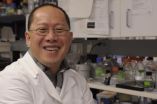(Press-News.org) By looking at the entire DNA from this one patient's tumor, researchers have found a genetic anomaly that provides an important clue to improving how this cancer is diagnosed and treated.
Researchers at the University of Michigan Comprehensive Cancer Center sequenced the tumor's genome through a new program called MI-ONCOSEQ, which is designed to identify genetic mutations in tumors that might be targeted with new therapies being tested in clinical trials.
The sequencing also allows researchers to find new mutations. In this case, an unusual occurrence of two genes – NAB2 and STAT6 – fusing together. This is the first time this gene fusion has been identified.
"In most cases, mutations are identified because we see them happening again and again. Here, we had only one case of this. We knew NAB2-STAT6 was important because integrated sequencing ruled out all the known cancer genes. That allowed us to focus on what had been changed," says lead study author Dan R. Robinson, research fellow with the Michigan Center for Translational Pathology.
Once they found the aberration, the researchers looked at 51 other tumor samples from benign and cancerous solitary fibrous tumors, looking for the NAB2-STAT6 gene fusion. It showed up in every one of the samples. Results are published online in Nature Genetics.
"Genetic sequencing is extremely important with rare tumors," says study co-author Scott Schuetze, M.D., associate professor of internal medicine at the U-M Medical School. "Models of rare cancers to study in the laboratory are either not available or very limited. The sequencing helps us to learn more about the disease that we can use to develop better treatments or to help diagnose the cancer in others."
The NAB2-STAT6 fusion may prove to be a difficult target for therapies, but researchers believe they may be able to attack the growth signaling cycle that leads to this gene fusion.
"Understanding the changes induced in the cell by the NAB2-STAT6 gene fusion will help us to select novel drugs to study in patients with advanced solitary fibrous tumors. Currently this is a disease for which there are no good drug therapies available and patients are in great need of better treatments," Schuetze says.
No treatments or clinical trials are currently available based on these findings. Additional testing in the lab is needed to assess the best way to target NAB2-STAT6. The gene fusion could also potentially be used to help identify solitary fibrous tumors in cases where diagnosis is challenging.
INFORMATION:
Additional authors: Yi-Mi Wu; Shanker Kalyana-Sundaram; Xuhong Cao; Robert J. Lonigro; Yun-Shao Sung; Rui Wang; Fengyun Su; Matthew K. Iyer; Sameek Roychowdhury; Javed Siddiqui; Kenneth J. Pienta; Lakshmi P. Kunju; Moshe Talpaz; and Arul M. Chinnaiyan from U-M; Chun-Liang Chen; Lei Zhang; Samuel Singer; and Cristina R. Antonescu from Memorial Sloan-Kettering Cancer Center; Juan Miguel Mosquera from Weill Cornell Medical College
Funding: National Cancer Institute grants: U01 CA111275, 5 P30 CA46592, P01 CA047179-15A2, and P50 CA140146-01; National Functional Genomics Center grant W81XWH-11-1-0520; U.S. Department of Defense; the Linn Fund, Cycle for Survival, the Alan Rosenthal Research Fund for Research in Sarcoma, the Weinstein Solitary Fibrous Tumor Research Fund, Doris Duke Charitable Foundation, Burroughs Wellcome Foundation, American Cancer Society, A. Alfred Taubman Institute at the University of Michigan.
Disclosure: The University of Michigan has filed for patent protection on the NAB2-STAT6 gene fusion and is currently looking for licensing partners to help bring the technology to market.
Reference: Nature Genetics, published online Jan. 13, 2013, DOI: 10.1038/ng.2509
Resources:
U-M Cancer AnswerLine, 800-865-1125
U-M Comprehensive Cancer Center, www.mcancer.org
Clinical trials at U-M, www.UMClinicalStudies.org/cancer
Researchers identify genetic mutation for rare cancer
Gene sequencing program gives researchers new leads to improve cancer treatment
2013-01-15
ELSE PRESS RELEASES FROM THIS DATE:
A quantum leap in gene therapy of Duchenne muscular dystrophy
2013-01-15
COLUMBIA, Mo.-- Usually, results from a new study help scientists inch their way toward an answer whether they are battling a health problem or are on the verge of a technological breakthrough. Once in a while, those results give them a giant leap forward. In a preliminary study in a canine model of Duchenne muscular dystrophy (DMD), University of Missouri scientists showed exactly such a leap using gene therapy to treat muscular dystrophy. The results of the study will be published in the journal Molecular Therapy on Jan. 15, 2013.
Muscular dystrophy occurs when damaged ...
New path discovered for future generation of glucose-measuring biosensors
2013-01-15
CIC bioGUNE researchers have opened a new pathway for the future development of biosensors that enable measuring the glucose in the blood, but which are also believed to be more reliable with other fluids, such as urine. To this end, a complex scientific process has been developed which has called into question a dominant paradigm amongst the scientific community with respect to the mechanisms of binding and communication between proteins.
The mechanisms of communication at subcellular level are based on the interaction between proteins or between proteins and metabolites ...
Plumber and spray painter high-risk occupations for asthma
2013-01-15
Despite known risks and recommendations for protective equipment, many people are still affected with asthma after exposure to chemicals at work. This is the finding of an international study of 13,000 people carried out at the Sahlgrenska Academy, University of Gothenburg, Sweden.
Asthma is among the most common adult diseases in the world. Despite the fact that the risks of chemical exposure have long been known and that there are well-established recommendations for handling chemicals and protective equipment, many cases of asthma are still caused by exposure to toxic ...
How the protein transport machinery in the chloroplasts of higher plants developed
2013-01-15
Halfway between bacteria and tree
How the protein transport machinery in the chloroplasts of higher plants developed
Moss Physcomitrella patens is an evolutionary intermediate stage
Together with colleagues from Sweden, RUB researchers have studied how the protein transport system of bacteria developed over time to form the system in the chloroplasts of higher plants. They explored the so-called signal recognition particles (SRP) and their receptors. Bioinformatic and biochemical analyses revealed that the moss Physcomitrella patens has evolutionarily old and new components ...
Designer bacteria may lead to better vaccines
2013-01-15
AUSTIN, Texas — Researchers at The University of Texas at Austin have developed a menu of 61 new strains of genetically engineered bacteria that may improve the efficacy of vaccines for diseases such as flu, pertussis, cholera and HPV.
The strains of E. coli, which were described in a paper published this month in the journal PNAS, are part of a new class of biological "adjuvants" that is poised to transform vaccine design. Adjuvants are substances added to vaccines to boost the human immune response.
"For 70 years the only adjuvants being used were aluminum salts," ...
Chemistry resolves toxic concerns about carbon nanotubes
2013-01-15
Safety fears about carbon nanotubes, due to their structural similarity to asbestos, have been alleviated following research showing that reducing their length removes their toxic properties.
In a new study, published today in the journal Angewandte Chemie, evidence is provided that the asbestos-like reactivity and pathogenicity reported for long, pristine nanotubes can be completely alleviated if their surface is modified and their effective length is reduced as a result of chemical treatment.
First atomically described in the 1990s, carbon nanotubes are sheets of ...
Born to lead? Leadership can be an inherited trait, study finds
2013-01-15
Genetic differences are significantly associated with the likelihood that people take on managerial responsibilities, according to new research from UCL (University College London).
The study, published online in Leadership Quarterly, is the first to identify a specific DNA sequence associated with the tendency for individuals to occupy a leadership position. Using a large twin sample, the international research team, which included academics from Harvard, NYU, and the University of California, estimate that a quarter of the observed variation in leadership behaviour ...
Neon lights up exploding stars
2013-01-15
An international team of nuclear astrophysicists has shed new light on the explosive stellar events known as novae.
These dramatic explosions are driven by nuclear processes and make previously unseen stars visible for a short time. The team of scientists measured the nuclear structure of the radioactive neon produced through this process in unprecedented detail.
Their findings, reported in the US journal Physical Review Letters, show there is much less uncertainty in how quickly one of the key nuclear reactions will occur as well as in the final abundance of radioactive ...
New research gives insight into graphene grain boundaries
2013-01-15
Using graphene – either as an alternative to, or most likely as a complementary material with – silicon, offers the promise of much faster future electronics, along with several other advantages over the commonly used semiconductor. However, creating the one-atom thick sheets of carbon known as graphene in a way that could be easily integrated into mass production methods has proven difficult.
When graphene is grown, lattices of the carbon grains are formed randomly, linked together at different angles of orientation in a hexagonal network. However, when those orientations ...
Facebook posts not easily forgotten
2013-01-15
Facebook posts resonate significantly more with human nature than books or even human faces, according to a new study by Laura Mickes and colleagues from the University of California San Diego in the US. The difference in memory between these microblogs and actual published words from a page is as striking as the difference in memory between amnesiacs and healthy controls. The work is published online in Springer's journal Memory & Cognition.
Online social networking is very popular, and allows people to post their thoughts as microblogs, an opportunity that people exploit ...
LAST 30 PRESS RELEASES:
Study finds brain care score can predict risk of stroke across racial groups
Key lung immune cells can intensify allergic reactions
Do hormones explain why women experience more gut pain?
New materials conduct ions in solids as easily as in liquids
Breakthrough of the Year: Renewable energy begins to eclipse fossil fuel-based sources
LLM use is reshaping scientific enterprise by increasing output, reducing quality and more
Introducing LightGen, a chip for ultra-fast, ultra-efficient generative AI
Astronomers see fireworks from violent collisions around nearby star
ACC/AHA issue new guideline on managing congenital heart disease in adults
Cosmic crash caught on camera
Is talented youth nurtured the wrong way? New study shows: top performers develop differently than assumed
Ants: An untapped resource in the development of antibiotics?
Archaeologists use AI to create prehistoric video game
Mitochondria migrate toward the cell membrane in response to high glucose levels
Tiny viral switch offers hope against drug-resistant bacteria
Most parents aware of early peanut introduction guidelines, but confused about details
HPV vaccine can protect against severe lesions of the vulva and vagina
Virtual care provision and emergency department use among children and youth
Quadrivalent HPV vaccine and high-grade vulvovaginal lesions
Insights into dry eyes gained from stem cell-derived tear glands
Researchers identify 166 human pluripotent stem cell lines available for use in clinical applications
Europa Clipper instrument uniquely observed interstellar comet 3I/ATLAS
UN University Report challenges climate change as sole trigger of Syrian Civil War, exposing governance failures in drought response
Real estate investment trust (REIT) acquisition associated with hospital closure and bankruptcy
New Raman imaging system detects subtle tumor signals
Boston Children’s receives a $7.5 million grant from Aligning Research to Impact Autism (ARIA) to provide clinical research coordination for the IMPACT Network
Spray-on antibacterial coating offers new protection for plants against disease and drought
ESMT Berlin study: What makes a first offer successful in negotiations
Groundbreaking ceremony marks the beginning of CTAO-South Array construction in Chile
Why swearing makes you stronger
[Press-News.org] Researchers identify genetic mutation for rare cancerGene sequencing program gives researchers new leads to improve cancer treatment



